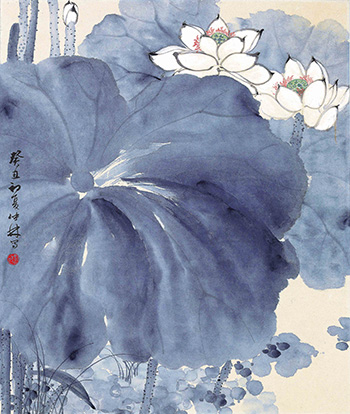PROVENANCE:
Acquired directly from the artist's daughter
ILLUSTRATED:
Elegance and Grace: A Commemorative Collection of Flower and Bird Paintings by Yu Chung-Lin, National Museum of History, Taipei, 2012, pp.172-173
Catalogue Note:
Painted in mid-summer, White Lotus featured a huge lotus leaf dominating the whole painting. The method of splash ink was applied at the center, with a careful treatment of adjacent objects, highlighting the smothering heat of summer. Using the contrast of bright white petals against the dominant blue colour of its leaves, the eye is dragged towards the edges, fully utilising the spaces of the paintings. Same as the previous paintings, the flowers were carefully depicted to display their different forms, adding character and vibrancy to the painting.
"Flower and Bird" is a prevalent genre among traditional Chinese painters. Each painter has their own characteristics. Among these artists is Yu Chung-lin, a gifted and well-acclaimed gongbi painter among the collectors’ circle. Inspired by his uncle Xu Zhonghai, a famous flower and bird painter, Yu started his practice early on. After the war in 1949, Yu moved to Taiwan and followed Jin Boqin. Since then, he devoted his lifetime in painting and gained his well-deserved fame among the art community.
Yu once wrote, "…I put a lot of effort on flower and bird paintings. My strategy is to meticulously observe an object, understand every detail of the subject matter, eg. the number of petals on a certain flower, its colour, its form in full bloom, its form in half bloom, the shape of its leaf, etc. When these figures are sketched in detail, as time goes by, one would know how to draw the figure with ease. Another way is to collect as many references of flower and birds from multifarious ways, such as through magazines. With regard to the elegance of a painting, one has to study traditional paintings. These paintings carries a fascinating aura which cannot be easily imitated and should be studied by learners. I have high respect to Song paintings, regardless of their landscape or their flower and bird paintings. In my opinion, one shouldn’t copy these paintings, but to feel them personally and learn from them, so that one could eventually paint with the aura."
There are a few points to note from Yu’s creative methodology: 1, Meticulously painting the details by observation; 2, Painstakingly studying Song paintings; 3, Creatively transforming a painting by blending multitude skills learnt from old masters.
Structure of a painting and matching of colours had always been the core elements to YU Chung-lin. The artist once said, "Harmony in colour scheme forms the core of the painting. Colour of flowers has always been the most eye-catching element, and with many flowers cluttering together, the treatment of colours could be a challenge. If the painting needs to be an extravagant one, colour harmony might not be the key. In this case, tonality is needed to highlight the subject matter; or emphasize the subject to make it stand out. This method might not be said previously by old masters, but it is observed to be their usual practice. Ma Lin's painting in the National Palace Museum is an example, with a boy in a very tiny scale at the corner, as he is not important to the painting. This method is a conventional yet modern concept."
Yu’s tactful application of skills and his detailed observation lifted his fame as a gongbi painter among art lovers in Taiwan and beyond.
